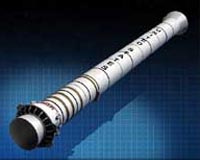 |
Seoul, Korea (Yonhap) Aug 17, 2009 South Korea's first space rocket is expected to mark a milestone in the country's budding space exploration ambitions, which the government says include building a lunar lander within the next 20 years. The Korea Space Launch Vehicle-1 (KSLV-1), set to blast off Wednesday afternoon, has given the country first-hand experience in designing, building and testing powerful space rockets, the Ministry of Education, Science and Technology said. It said if the launch is successful, Seoul could join the ranks of the exclusive "space club" - countries that operate launch facilities and build satellites sent into orbit using locally assembled rockets. The KSLV-1, standing 33m tall with a diameter of 2.9m, can generate 170 tons of thrust and lift a 100kg satellite into orbit. Seoul has spent 502.5 billion won (US$406.5 million) since 2002 to build the rocket and learn related technologies. The first-stage main rocket was built in Russia with no sharing of technology, but 150 South Korean engineers worked side-by-side with their Russian counterparts for almost two years on the design and systems development. "Critics have said that South Korea still cannot make a powerful rocket engine on its own, but what may be more important is that local engineers now know how a rocket is built from scratch," said Moon Hai-joo, a senior science ministry official. This, he claimed, could be a greater asset than simply acquiring rocket-engine technology as the country prepares to build an entirely South Korean-made space rocket by 2018 and a probe that can orbit the moon by 2025. He stressed no country currently shares space exploration-related technologies and know-how, making it doubly hard to see how they design new rockets. Related to South Korea's potential in this sector, experts said local capabilities are roughly at 70-75 percent of the level of leaders in the overall rocket sector, while the country's capabilities in the critical engine area stand at 60-70 percent of the level achieved by countries like the United States and Russia. Despite such shortcomings, the KSLV-1 can be viewed as an important stepping-stone for the country, experts said. "The rocket should be thought of as laying the foundation for all future development," said Chae Yeon-seok, vice president of Young Astronauts Korea, a state-supported organization dedicated to promoting young people's interest in space exploration. The aerospace expert said that while South Korea started development 40 years later than others, it has shown its engineering prowess by launching the 17-ton thrust Korea Sounding Rocket-3 rocket in 2002 without any foreign assistance. "Such a feat is not easy, and if local engineers have learned from their Russian partners and there is adequate funding, the country could make great strides," he said. Chae added that what the country needs the most is to construct an up-to-date engine test facility to see if locally made rocket engines meet operational requirements. The state-run Korea Aerospace Research Institute (KARI), which is responsible for the country's space program, said besides learning the entire process of how a rocket is made, local engineers built the second stage rocket and the nose fairing to house the satellite. It said that while work was being carried out with Russia in the past few years, Seoul almost completed work on a 30-ton thrust engine and started initial design work on a 75-ton thrust rocket. KARI said another benefit reaped from the KSLV-1 was the construction of the Naro Space Center at Oenarodo Island off South Korea's southern coast. The center, 485km south of Seoul, has state-of-the-art facilities that can be used to launch rockets and satellites. South Korea has sent 10 satellites into space, with nine more to be sent by 2015. Plans are underway to build an indigenous rocket by 2018, a probe that can orbit the moon by 2020 and a lunar lander by 2025. "On average, a satellite may be sent up every year, and if such machines can be sent by indigenous rockets, it could save the country money and expense," a KARI engineer said. Other benefits that can be derived by the successful launch of the KSLV-1 are growth in the country's science and technology levels, national defense and prestige. A country with rocket-launch capability can build and send its own intelligence satellite without concerns that sensitive technology may fall into the wrong hands. Besides the aerospace field, a successful launch and more support for the sector can lead to positive spin-offs in technology that can be used by local businesses. Technologies for many common products like digital cameras, mobile phones, car navigation systems and water filters were originally developed for space exploration.
Source: Yonhap Share This Article With Planet Earth
Related Links South Korea Ministry of Education, Science and Technology Rocket Science News at Space-Travel.Com
 NASA And ATK To Conduct Full-Scale Motor Test For Ares I Rocket
NASA And ATK To Conduct Full-Scale Motor Test For Ares I RocketWashington DC (SPX) Aug 13, 2009 NASA and Alliant Techsystems Inc. will conduct the first full-scale, full-duration test of the new first-stage solid rocket motor for the Ares I rocket at 1 p.m. MDT, on Tuesday, Aug. 25. The test will take place at the ATK test facility in Promontory, Utah. The static firing of the five-segment solid motor, designated Development Motor -1, will last two minutes. The goal is to obtain valu ... read more |
|
| The content herein, unless otherwise known to be public domain, are Copyright 1995-2009 - SpaceDaily. AFP and UPI Wire Stories are copyright Agence France-Presse and United Press International. ESA Portal Reports are copyright European Space Agency. All NASA sourced material is public domain. Additional copyrights may apply in whole or part to other bona fide parties. Advertising does not imply endorsement,agreement or approval of any opinions, statements or information provided by SpaceDaily on any Web page published or hosted by SpaceDaily. Privacy Statement |